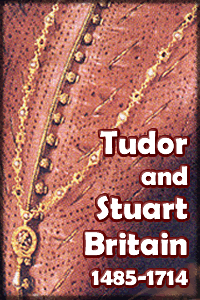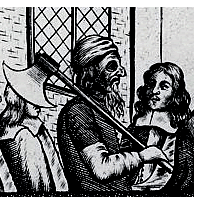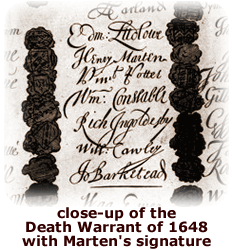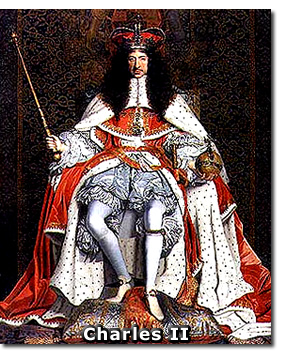

To Kill
the
King.
The Making
of an English
Regicide.
By Ronald Fritze
Posted on December 10, 2008, from Athens, Alabama
The Villanie of the Rebells proceeding now so far as to Trie,
Condemne, and Murder our excellent King, the 30 of this Moneth,
struck me with such horror that I kept the day of his Martyrdom
a fast, and would not be present, at that a excecrable wickednesse; receiving the sad [account] of it from my Bro: Geo. and also
by Mr. Owen, who came to Visite this afternoone,
recounting to me all Circumstances.
John Evelyn. Diary (1649).
The 30th of January 1649 was a cold day in London. It was also the day appointed for the execution of Charles I, the captive king of England, Scotland, and Ireland. Charles I confronted his last day of life with commendable courage, so commendable that it was probably his finest hour.
Although various Presbyterian ministers sought to attend to him during his final hours, the King rejected them and instead sought spiritual counsel from William Juxon, the bishop of London. He was also attended by Thomas Herbert, the well-known travel-writer and a Parliamentarian official. Herbert treated his royal prisoner fairly and respectfully, and may even have developed a genuine and deep respect for Charles I. On that last day, Charles I showed his gratitude by giving Herbert his watch, which became a treasured heirloom of the Herbert family. After the restoration of the monarchy in 1660, Charles II showed his appreciation of Herbert’s service to his father by making him a baronet.
Two Shirts and No Fear.
Charles I prepared for his execution through prayer and Holy Communion with Bishop Juxon. Since it was a bitterly cold day, the King put on two shirts to keep himself warm on the scaffold. He did not want to shiver from the cold and have it said that he was trembling in fear of his impending death.
His execution was fated not to take place at dawn. Instead the king waited and waited in his rooms with Juxon and Herbert for the knock on the door from his escort of guards. Elsewhere Dutch diplomats and representatives of the Scots pleaded for the life of the King. Even more important in delaying the execution was the frantic debate over a parliamentary bill making it a crime to declare the King’s son, Charles the Prince of Wales, to be the new king on the death of his father.
At last, the dreaded knock was heard. It was 2 o’clock. The guards took the King to the scaffold within the grounds of the Whitehall Palace. Charles I wanted to walk briskly to show that he was anxious to go on to his reward in the afterlife.
Arriving at the courtyard, the King saw that mounted troopers were lined up to keep spectators away from the scaffold. The King mounted the scaffold accompanied by Juxon. The executioner and others stood waiting.
Who Struck the Lethal Stroke?
All sorts of rumors would later circulate about the identity of
 the executioner. It was claimed that the normal public executioners refused to do the horrendous deed. According to one version, two ordinary soldiers volunteered to serve as executioners, but other stories credited the Puritan minister Hugh Peter with performing the execution. Another version said the masked executioner was actually Oliver Cromwell or Coronet George Joyce, the Parliamentary officer who brought the King to London from his prison on the Isle of Wight.
the executioner. It was claimed that the normal public executioners refused to do the horrendous deed. According to one version, two ordinary soldiers volunteered to serve as executioners, but other stories credited the Puritan minister Hugh Peter with performing the execution. Another version said the masked executioner was actually Oliver Cromwell or Coronet George Joyce, the Parliamentary officer who brought the King to London from his prison on the Isle of Wight.
A rather out-of-touch French account improbably claimed that Cromwell and his rival the commander-in-chief of the Parliamentary armies, Thomas Fairfax, served as the King’s executioners. Fairfax was in fact adamantly opposed to the execution of Charles I and pleaded for clemency.
Charles I gave a final speech in which he claimed to be innocent and unjustly condemned. When he finished, he placed his head on the execution block. The executioner beheaded him with one stroke of his axe. At the instant of the lethal stroke, one witness recorded, the crowd made “such a groan as I never heard before, and desire I may never hear again.” The mounted troopers moved forward to clear off the spectators, but some determined individuals managed to get through and dipped their handkerchiefs in the dead king’s blood. Others carried away soil from under the scaffold.
'Cruel Necessity'
Or Unholy Travesty?
The corpse of the King was transported to the embalmer, then kept at St. James Palace for a week. During that time, according to one story, a mysterious figure dressed in a cloak and muffler approached the coffin of Charles I and was heard to remark, “Cruel necessity.” Witnesses claimed that the voice and the walk of the cloaked man matched those of Oliver Cromwell.
It was decided to bury Charles I in St. George’s Chapel at Windsor Castle, where Henry VIII and his wife Jane Seymour were
 buried, because it was less accessible to the public.
buried, because it was less accessible to the public.
The execution of Charles I was a shocking event not only for the English people, but also for the Scots, the Irish, and other Europeans. To try a king in a court of law, find the monarch guilty, and then proceed to execute him for his crimes was unprecedented. Kings were supposed to be God’s representatives on earth and as such, they were sacrosanct.
A cult of King Charles the Martyr quickly developed among committed Royalists. The cult persists to this day. Many at the time mourned for their dead king. Others, however, believed that Charles I amply deserved to be executed. For them, he was “a man of blood” because of his role in bringing on the Second Civil War. The critics viewed him as a tyrant whose evil actions also had brought on the First Civil War, which caused many deaths and much destruction.
The Origins of a Future Regicide.
One who definitely thought that Charles I deserved to be executed was Henry Marten (1601/2-1680). Marten was the son of Sir Henry Marten (c1561-1641), a civil lawyer and judge. The elder Marten, a moderate Puritan, opposed the religious policies of Archbishop William Laud. Despite this opposition, the elder Marten maintained good relations with Charles I and managed to retain his lucrative offices in the government and the Church of England until his death in 1641. Apart from his disapproval of Laudian religious policies, there was nothing in the career of the elder Marten that would have nurtured his son and heir and as a radical Parliamentarian and a future regicide.
The young Henry Marten led the usual early life of the eldest son of a well-to-do member of the English gentry.
 He graduated from Oxford University with a BA in 1620, entered the Inner Temple in London to study the common law in 1619, and traveled in Europe, mostly in France, but atypically did not journey to Italy. While in France he developed a liking for the French stoical philosophers. In terms of religion, the young Marten was not a Puritan of any description. As the antiquarian John Aubrey would later put it, “he [Marten] was as far from a Puritane as light from darknesse.”
He graduated from Oxford University with a BA in 1620, entered the Inner Temple in London to study the common law in 1619, and traveled in Europe, mostly in France, but atypically did not journey to Italy. While in France he developed a liking for the French stoical philosophers. In terms of religion, the young Marten was not a Puritan of any description. As the antiquarian John Aubrey would later put it, “he [Marten] was as far from a Puritane as light from darknesse.”
Rather, Henry Marten acquired a reputation for womanizing and drunkenness. It was said that Marten became intoxicated easily. Aubrey related that he “was a great lover of pretty girles” and spent much of his income on them.
Elizabeth, Margaret, Mary —
And an Insult from the King.
He married a woman named Elizabeth in 1627. She died in childbirth seven years later. His father quickly arranged for the young Henry to married the rich widow Margaret Lovelace Stanton in 1635. Margaret and Henry remained legally married until her death in 1679. It was said by Aubrey that the young Henry entered into the marriage “something unwillingly.” The unhappiness of the marriage is borne out by the fact that Marten would later take a common law wife named Mary Ward by no later than 1649 and possibly as early as 1640. Mary Ward claimed the name of Mary Marten and stuck by Henry Marten through his financial problems and his imprisonment after the Restoration until his death in 1680.
Although Marten’s womanizing seems to have ended when he developed the stable relationship with Mary Ward, it was said that as a young man, he often pursued married women for adulterous affairs. Marten’s licentious reputation did not endear him to the strait-laced Charles I. On one occasion the sanctimonious King spotted Marten in Hyde Park where both were attending a race. The irate King exclaimed in Marten’s hearing, “Let that ugly Rascall be gonne out of the Parke, that whore-master, or els I will not see the sport.” It was a royal request that could not be refused or ignored. Marten withdrew but harbored a bitter grievance against the censorious Charles I. Was this incident the genesis of a radical Parliamentarian?
Not So Handsome,
But Otherwise a Jolly Good Guy.
In fact, Marten was a well-regarded and likeable individual. Charles I, however, was correct in one respect. Marten was ugly, or as Aubrey described it, “his face not good.” His personality was a different story. It was said that “his company was incomparable” and that he was considered a great wit both in Parliament and in society. His pointed speeches could be very persuasive. He showed no arrogance — haughty self-importance was a common failing among the English elite of the mid-seventeenth century — but was rather humble, generous not greedy, a seeker of justice, and an ardent patriot in his own unconventional manner.
Marten served as a Member of Parliament for Berkshire in both the Short and the Long Parliaments. When the English Civil War broke out, he raised and commanded a regiment using his own money. From the very beginning he was very much personally opposed to Charles I and advocated the deposition of the King and the exclusion of his family from rule. He strongly questioned the validity of monarchy. These views got him imprisoned in the Tower of London in 1643 and expelled from Parliament, although he was readmitted in 1646.
After 1646 he allied himself with the democratizing political movement of the Levelers and was friends with the prominent Leveler leader, John Lilburne.

Serving on the high court that tried Charles I, he attended its meetings as often as he could and signed the King’s death warrant. Supposedly when he and Oliver Cromwell had signed the warrant for the execution of Charles I, the two men playfully smeared ink on each other’s face. Despite their cooperation in bringing about Charles I’s execution, Cromwell and Marten were not allies or friends.
During the 1650s, his critics claimed that he was an atheist, although Marten maintained that he was just a religious skeptic and did not know if God’s existence could be proven or not. He also defended the right of Quakers to meet and to worship.
Not Willing to Flee,
Marten Is Arrested and Tried.
When Charles II was restored as king in 1660, it was thought that Marten, like other regicides, had fled to exile in
 continental Europe, but that was not the case, even though Charles II had exempted the regicides from pardon. One would have expected that as an implacable enemy of Charles I, Marten would have faced certain execution by the returning Charles II.
continental Europe, but that was not the case, even though Charles II had exempted the regicides from pardon. One would have expected that as an implacable enemy of Charles I, Marten would have faced certain execution by the returning Charles II.
Marten was arrested and brought to trial. In the court case that followed, Marten argued on the basis of technicalities that he was not one of the indicted regicides. The high court found him guilty anyway. Instead of execution, Marten was subjected to internal exile.
It has been suggested that the Royalists declined to execute Marten because he was well-known and popular, and that his death would have transformed him into a dangerous martyr for the radical cause. Marten was also a known opponent of Oliver Cromwell. People who opposed Cromwell were generally spared execution. Furthermore, it is likely the Royalists spared Marten out of gratitude for his having been generous and merciful to Royalists accused by the Commonwealth government of war-time atrocities.
From Berwick to Windsor
To Death at Dinner.
His first prison was Berwick Castle. During that time officials seized the letters he had written to Mary Ward while awaiting trial in the Tower of London. The letters were published in 1662 under the title Coll. Henry Marten’s Familiar Letters to his Lady of Delight as a way of discrediting him. But in John Aubrey’s judgment, “tis not to his disgrace; there is Witt and good nature in them.”
He was moved to Windsor Castle in 1665 but Charles II did not want a regicide in such close proximity to him. So in 1668, the authorities transferred Marten to Chepstowe Castle, where he lived with Mary Ward while his legal wife Margaret stayed in the family home at Longworth Lodge, Berkshire. The long-suffering Margaret sent money to pay for a comfortable imprisonment for her unfaithful husband until the day she died in 1679.
Marten did not outlive Margaret by much, passing away in 1680. He choked to death on his dinner. He was almost 80, having survived to a ripe old age, particularly by the standards of the seventeenth century.
Henry Marten’s career shows us that not all Parliamentarians were Puritans, or Godly, or Saints. His personal animosity with Charles I also provides evidence of the intimate and small-scale of political relations among the English ruling elite. These people knew each other, or at least knew of each other. Marten's own actions and ultimate fate show that many among the elite were capable of mercy and forgiveness of their enemies and opponents in spite of having lived through England’s very bloody, long, and acrimonious Civil Wars of the mid-seventeenth century.
If the general distraction and confusion
which is spread over the whole kingdom
doth not awaken all men to a desire and longing
that those wounds which have so many years together
been kept bleeding may be bound up,
all we can say will be to no purpose.
Charles II, “Declaration of Breda” (1660).

To read Dr. Fritze's previous Tudor-Stuart essay, Rob Ride, Ride Rob to Scotland: The Intrepid Gallop of Sir Robert Carey, click the reading glasses above.

|